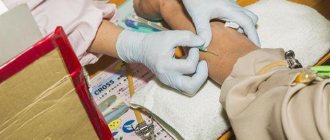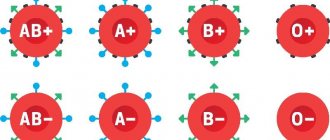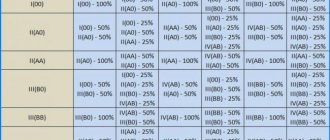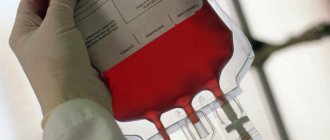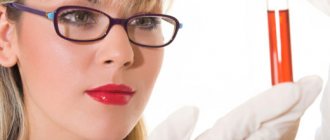It is believed that blood type plays an important role in the formation of certain traits inherent in a person’s personality and health .
Having information about the features associated with these groups will help not only bring harmony into your own life by carrying out certain activities, but also, perhaps, save someone’s life in time by taking part in blood transfusion or donation procedures.
Features and Specifications
Human blood varies by group and Rh factor. This is due to the individual antigenic characteristics of red blood cells.
Having belonging to the same blood group, people have similar character traits and have an equal ability to withstand adverse factors.
This indicator sets certain dietary requirements and regulates the body’s food preferences.
History of origin
Blood groups are the product of centuries of evolution of the immune system, which gradually learned to adapt to rapidly changing environmental conditions.
Reference! There is no consensus among scientists about the origin of blood groups. It is believed that primitive people had a single group, the first, and only a hundred thousand years later the second appeared.
There are several versions of the mutation of the original group - it could be exposure to various infections or a change in diet.
One of the most unique facts related to the nature of blood is the phenomenon of the 2nd blood group, and blood with a negative Rh factor, the so-called “royal”, or “blood of the gods” (written AA (-) or AA Rh - ). What does it mean?
Features of the nature of the media
Calmness and sociability are the main characteristics of modern carriers of the second blood group. They are able not to become attached to places and people, and easily perceive any changes.
Attention! The main guideline of life on the path of these people is their family and environment.
They prove themselves to be excellent performers and are able to work in almost any field, but not as a leader. But any boss who has such an employee on his staff can only be envied, because no matter what task he is given, it will be completed in the most ideal way.
- Above all, they value order, consistency and organization.
- They are distinguished by their love for children, hard work and perseverance, and cannot stand it when something is not done punctually enough.
- An overly active lifestyle is not for them; they are too consistent and static for that. Their greatest pleasure is communicating with friends.
The character flaws of these people include the inability to lead and make operational decisions. There may also be a tendency to nervous breakdowns due to the habit of showing unlimited patience for a long time.
Who are people with the 2nd negative blood group and why it is called “royal”, is described in the video:
Characteristic diseases
The condition and type of blood largely determine the condition of the body as a whole, being an obstacle to the entry of pathogenic bacteria and foreign organisms into it:
- Type 2 negative blood is very thick and can cause arterial and venous clots,
- Patients with this blood type are often diagnosed with low gastrointestinal acidity,
- The second group can potentially lead to renal failure, pyelonephritis, urolithiasis,
- Liver diseases, allergies, anemia, diabetes mellitus and rheumatism often occur,
- Anemia can often be observed when the amount of hemoglobin and red blood cells in the blood decreases,
- Thalassemia hereditary hemolytic anemia can also become a problem. A disease in which hemoglobin synthesis is impaired
- Hereditary skin diseases are also common. Dermatoses caused by staphylococci.
Mental health requires special attention.
The increased risk for all kinds of neuroses, anxiety states and, in general, the mental instability of people in the second group obliges them, if possible, not to get involved in situations associated with the need to be under prolonged stress or tension.
These kinds of unfavorable factors will have an extremely detrimental effect on the psyche, greatly reduce the quality of life and can even lead to chronic depression.
It is recommended to take timely preventive sedatives - pharmaceutical ones or prepared at home based on medicinal herbs, walks in the fresh air, and meditation.
Who discovered the human blood type
The Austrian immunologist Karl Landsteiner succeeded in identifying the class of human biological material in 1900. At this time, only 3 types of antigen were identified in the membranes of erythrocytes - A, B and C. In 1902, it was possible to identify the 4th class of erythrocytes.
Karl Landsteiner was able to make another important achievement in medicine. In 1930, the scientist, in tandem with Alexander Wiener, discovered the Rh factor of blood (negative and positive).
Compatibility
The theory that different blood types have compatibility criteria arose in the second half of the twentieth century.
Compatibility problems are indeed especially pronounced during transfusion:
- The second blood group is compatible only with the first, with the complete absence of antigen proteins, and with the second, which completely repeats it.
- To antigens B of the remaining groups, as a rule, an immune response occurs that can lead to the death of the patient.
- A negative Rh factor can only absorb a similar substance. The positive blood introduced will cause the blood to clot within the bloodstream. Such an incident is a serious threat to life.
Agglutination is a manifestation of an immediate response of the immune system. Immunoglobulin proteins, under the influence of T-helper cells, actively attack invading antigens, clinging to them from different sides and forming immune complexes. These complexes are attacked by monocytes, which devour them and dissolve them inside with special enzymes.
Rh factor
During scientific research in 1940, an antigen was found in the blood of macaques, which later received the name Rh factor. It is hereditary and depends on race. Those people who have this antigen in their blood are Rh positive, and if it is absent, they are Rh negative.
Transfusion compatibility:
- Rh negative is suitable for transfusion to people with Rh negative;
- Rh positive is compatible with any Rh blood.
If you use Rh-positive blood for a patient with a Rh-negative category, then special anti-Rhesus agglutinins will be produced in his blood, and with another manipulation, red blood cells will stick together. Accordingly, such a transfusion cannot be carried out.
Any transfusion is stressful for the human body. Whole blood is transfused only if the loss of this biological fluid reaches 25% or higher. If less volume is lost, blood substitutes are used. In other cases, transfusion of certain components, for example, only red blood cells, is indicated, depending on the type of lesion.
Diet
A nutritional system based on blood type was proposed by the American naturopath Peter D. Adamo in the 90s of the 20th century and became widespread throughout the world.
Important! The meaning of the system is that due to the different interactions of blood of different groups with products entering the body, they can bring both benefit and harm to it.
Therefore, for representatives of each blood group, a separate diet should be developed that maximally satisfies the body’s needs and promotes weight loss.
Carriers of the second blood group with a negative Rh factor can boast of good adaptation to various changes in diet conditions.
Their gastrointestinal tract is well adapted to plant foods rich in carbohydrates, but their ability to absorb proteins and fats of animal origin is reduced.
General recommendations regarding diet:
- The food consumed must be environmentally friendly and clean. To select suitable products, you can purchase a tester that allows you to determine the level of nitrates. When processing vegetables and fruits, rinse them with boiled water at the final stage,
- Difficult to digest meat and dairy products should not be present in the diet. Their consumption will lead to insulin reactions, the metabolism will slow down, which, in turn, will lead to the initial stage of obesity. Dairy products can be replaced with soy milk, cottage cheese and cheese,
- Wheat consumption should be limited, as it increases the acidity of muscle tissue,
- It is recommended to consume brown algae, seafood, iodized salt and spinach in sufficient quantities.
- If possible, stick to a vegetarian menu, including vegetables, cereals, and legumes in your diet every day.
The blood type diet is described in the video:
Foods you shouldn't eat
To maintain an effective diet, moderate consumption requires the following products:
Fruits
- Kiwi,
- Quince,
- Nectarine,
- Melon,
- Pear,
- Persimmon,
- Apples.
Nuts: Almonds and almond butter.
Dessert
- Jelly.
Dried fruits
- Raisin
Spices and seasonings
- Bergamot,
- Paprika,
- Rosemary.
Berries
- Strawberries
Cereals and cereals
- Rice bran
Protein products: Quail eggs.
Vegetables
- Radish.
Fish
- Halibut,
- Herring,
- Flounder.
The following products are strictly not recommended for consumption:
Vegetables
- Hot and sweet peppers,
- Potato,
- Tomatoes,
- Eggplants,
- Cucumbers.
Fruits
- Mango,
- Any citrus fruits.
- Banana,
- Papaya,
- Coconuts.
Fish: any fish that has been salted.
Sauces and seasonings
- Mayonnaise,
- Ketchup,
- Apple vinegar.
Mushrooms
- Champignon
Protein products:
- Partridge meat,
- Goose meat,
- Calf liver.
Beverages
- orange juice,
- Black tea,
- Soda.
Table
To quickly navigate the recommendations, you can use the table below.
When choosing a category of products recommended for limited consumption for your menu, you need to carefully monitor the body’s reaction.
Reference! If after consumption there are signs of individual intolerance, an allergic reaction, discomfort in the stomach, a feeling of heaviness, you should independently move the irritating product to the category of not recommended.
| Product type | Fits | In limited quantities | Not recommended |
| Meat | White poultry meat | Everything except what is permitted | |
| Fish and seafood | Salmon, trout, perch, cod, mackerel | sardine | Flounder, herring, anchovy, octopus, crabs, oysters, squid, shrimp |
| Dairy and eggs | Chicken eggs, yogurt, bifidoc, goat cheese, kefir, cottage cheese | Milk, quail eggs | |
| Fats | Olive and linseed oil | Cod liver oil | Corn, peanut, sesame oil |
| Beans, nuts, seeds | Lentils, green and spotted beans, pumpkin seeds, walnuts, | Raw sunflower seeds | Red and white beans, chickpeas, peanuts, pistachios, Brazil nuts |
| Cereals | Sprouted wheat, buckwheat. In the form of flour: rice, oats, rye | Rice, barley, corn, couscous | White and wheat flour, semolina |
| Fruits, vegetables, berries, mushrooms, greens | Broccoli, carrots, artichoke, onion, garlic, leafy greens, parsley, spinach, figs, dates, pineapple, prunes, grapefruit, lemon, blueberries, cranberries, cherries | Beetroot, cabbage, turnip, cucumber, asparagus, avocado, apple, peach, pear, strawberry | Eggplant, tomato, potato, bell pepper, radish, banana, orange, kiwi, melon, persimmon, grapes, mango, mushrooms |
| Beverages | Water, fruit drinks, freshly squeezed juices, green tea | Coffee, dry red wine, black tea | Alcohol, sweet carbonated drinks |
| Condiments, spices | Soy sauce, ginger, mustard | Sugar, salad dressings | Mayonnaise, ketchup, apple cider vinegar, pepper, starch |
Can your blood type change?
In medical practice, there are cases of changes in group affiliation during pregnancy or due to serious illnesses. This is because in such conditions there can be a strong increase in the production of red blood cells. At the same time, the gluing and destruction of red blood cells slows down. In the analysis, such a phenomenon is reflected as a change in markers in the plasma composition. Over time, everything falls into place.
Blood class, like the Rh factor, is determined genetically in a person before birth and cannot change throughout life.
Features of physical activity
Characteristic features of negative blood group 2 are also present in sports hobbies. Such people especially benefit from brisk walking and light, short running. Both types of exercise are very effective in preventing the development of heart failure and other heart diseases.
Sports with an emphasis on developing strength, but static ones, are very well tolerated: weightlifting, training in the gym to build muscle mass, wrestling, rowing, cycling, etc.
The load must be carefully dosed and strictly guided by subjective sensations in the heart.
Separately, it is necessary to say about the second negative blood group during pregnancy. Due to the initial tendency of the cardiovascular system to develop pathologies, during pregnancy it is worth completely eliminating serious physical activity, even classical fitness for expectant mothers.
You should limit yourself to active walks, without increasing the pace.
Tendency to diseases and pathologies
Weak points in the body of people with the second group will be:
- The cardiovascular system;
- Gastrointestinal tract;
- Kidneys;
- Liver and bile ducts.
This implies the likelihood of developing similar diseases:
- Heart failure;
- Myocardial infarction;
- IHD (coronary heart disease);
- Vegeto – vascular dystonia;
- Hypertonic disease;
- Gastritis;
- Peptic ulcer;
- Inflammation of the bile ducts, pancreatitis;
- Pyelonephritis, etc.
In addition, there was a high tendency to develop disorders of the immune system.
This entails the inability to resist cancer cells. It is in people with this group that cancer most often occurs. In order to prevent them, one should actively strengthen the immune system, which resists cancer cells in the process of their formation.
Allergic reactions are also a consequence of impaired immune function, and this is another disease that often occurs in people with the blood type described above.
Why is Rh incompatibility dangerous?
Determination of the Rh factor is the most important diagnostic point during organ transfusion or transplantation: if the Rhesus factor does not match in the recipient’s blood, a powerful immunological reaction occurs, in which proteins - agglutinins - that destroy red blood cells are formed.
When an inappropriate rhesus is re-introduced, they begin to intensively destroy red blood cells, which leads to oxygen starvation of the organs and systems of the body and can end very badly.
Rh factor and pregnancy
Determining the Rh factor during pregnancy is also of paramount importance - if the parents have a different Rh factor and the fetus inherits the Rh factor from the father, then serious problems can arise.
A particular risk is posed by the situation with a positive Rh in the child and negative in the mother : the Rh conflict is expressed in the production of antibodies by the fetal red blood cell as an immune response to the mother’s blood.
However, in most cases, the first pregnancy in such cases has a positive outcome, since the production of antibodies occurs quite slowly and the fetus has time to form without any problems.
Subsequent pregnancies require a very careful approach, since antibodies produced during the first pregnancy tend to remain in the woman’s blood for a long time in the form of “memory cells.” The degree of risk of a second and subsequent pregnancy directly depends on the volume of the child’s red blood cells entering the mother’s bloodstream.
This leads to the following consequences:
- The child also suffers from Rh conflict: both in utero and immediately after birth, he has hemolytic disease (jaundice of newborns), which is expressed in the intensive destruction of red blood cells.
- A large load on the liver and kidneys, trying to increase the production of red blood cells,
- Destruction of the meninges,
- Severe oxygen deprivation,
- Edema.
To prevent this, a blood transfusion is performed (up to 75% of the child’s total blood), as a result of which destroyed red blood cells, bilirubin and antibodies are removed.
